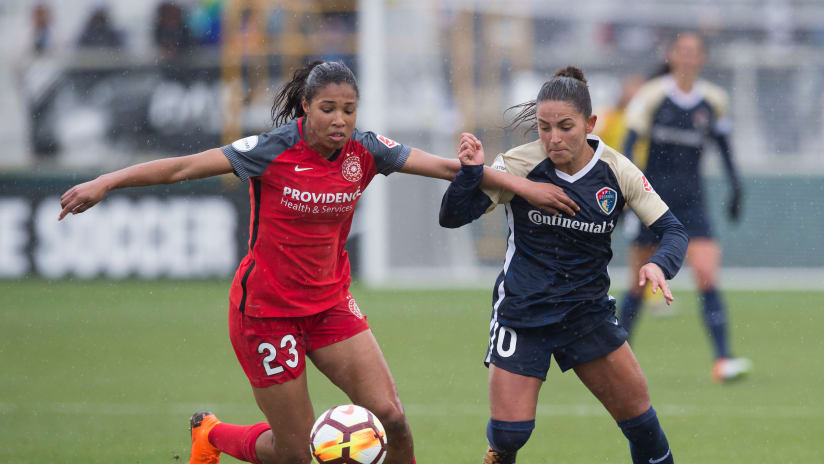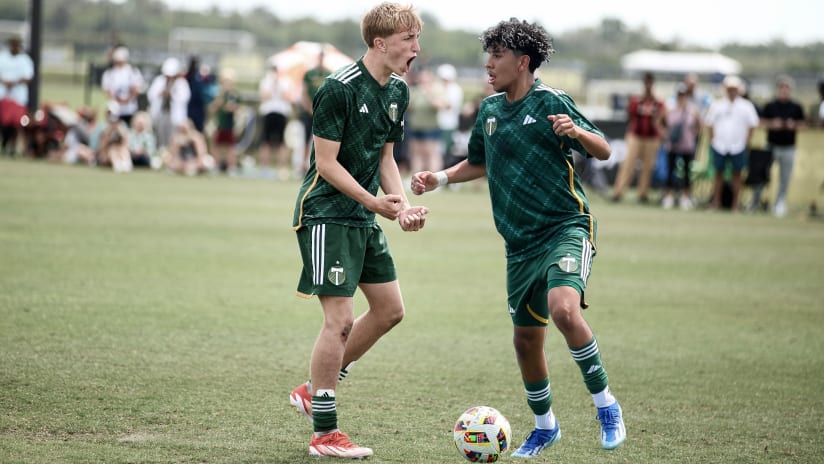Last season, the North Carolina Courage led the NWSL in shots taken, averaging 12.7 attempts per game. Out of context, who knows what 12.7 means, but compared to the rest of the league, it turned out to be a relatively huge number. In terms of shots, the gap between North Carolina the next-most prolific team, the Houston Dash, was larger than any other gap on the list, save the one between the ninth (next-to-last) and 10th place teams on the list.
North Carolina just shoots. They do it on sight. They do it as a matter of principle.
They also don’t seem too picky about the quality of those shots. The 41.9 percent of their attempts that were put on target was last in the NWSL. If you had a field worth of NWSL players wearing each team's uniforms, taking shots from the places they do during their run of play, the ones wearing Courage blue would be least likely to get their shots on target.
Team |
Shots Taken |
Shots on Target |
Shots per Game |
% on Target |
Goals |
|---|---|---|---|---|---|
North Carolina |
305 |
138 |
12.7 |
42.0 |
38 |
Houston Dash |
282 |
136 |
11.8 |
48.2 |
23 |
Sky Blue FC |
261 |
141 |
10.9 |
54.0 |
42 |
Orlando Pride |
255 |
133 |
10.6 |
52.2 |
45 |
Chicago Red Stars |
246 |
124 |
10.3 |
50.4 |
33 |
Seattle Reign |
243 |
122 |
10.1 |
50.2 |
43 |
FC Kansas City |
240 |
102 |
10.0 |
42.5 |
29 |
Washington Spirit |
228 |
111 |
9.5 |
48.7 |
30 |
Portland Thorns |
226 |
109 |
9.4 |
48.2 |
37 |
Boston Breakers |
194 |
83 |
8.1 |
42.8 |
24 |
That’s important context when you consider Saturday’s numbers. Opening the season in Cary, North Carolina, against the NWSL Shield-holding Courage, Thorns FC was outshot 20-3. The final score was only 1-0 in favor of the Courage, but shot numbers after 90 minutes portrayed a steamroller gliding over a pothole.
That just wasn’t the case. Over the match’s first 36 minutes, the teams were on even footing, and it was only a stretch of corner kicks toward the end of the first period that tilted the match in the Courage’s favor. To open the second half, Portland regained its footing, but over the middle 15 minutes, North Carolina turned the match. There’s no doubt that the Courage were the better team on Saturday, but you don’t even have to watch the game to know that 20-3 is a deceiving indicator.
For instance, did you know that the Thorns were next-to-last in shots taken last season? I suppose you did, since we put up that table above, but in this context, it's a fact worth repeating. The team finished fifth in the league in goals scored, eight behind the league-leading Orlando Pride (who scored 45), but only took 9.4 shots per game – 35 percent fewer than the Courage. Yet come the final whistle of game 24, North Carolina scored 38 goals, and Portland scored 37.
Particularly in a game played at Sahlen’s Stadium at WakeMed Soccer Park, we should have expected North Carolina to dominate the shot totals. To that extent, though? Maybe not on style alone, but factor in each team’s absences – the Courage missing star midfielder Sam Mewis while the Thorns were without Hayley Raso, Tobin Heath, Andressinha and Emily Menges – and this theoretical expected shots difference that we've just conjured up starts to get wider.
There is a point in this conversation, though, where you have to question the reliance on shot totals as a good descriptor of how matches were played. A decent amount of time, those totals do a good job to telling us how a match tilts. When stylistic differences are so vast, though – when philosophies about what are and aren’t good shots differ so much, the premise behind comparing aggregates falls apart. In some games, you can't just assume that, with enough data points, the quality of the shots will even out. When two teams have such drastically different approaches, shot totals become superficial.
Expected goals models have gone a long way toward addressing this "quality gap" in shot data, but even there, there’s a premise that can’t be teased out: that all good scoring chances result in shots. They don’t. The cutting cross that has to be punched by a keeper before it finds its target is much more dangerous than a speculative shot from 40 yards. The open player that is taken down from behind before a shot can get off was far more likely score that the desperate header on an overcooked corner far wide of the far post.
There’s also the idea of a goalkeeper who, aggressive off her line to play balls sent into the area, can smother chances before they ever reach the stat sheet. North Carolina’s Sabrina D’Angelo did this constantly on Saturday. For those curious, check the 69th and 79th minutes.
These are moments that get goalkeeper coaches leaping off their bench, screaming proud, effusive encouragement, knowing all the work that went into programming a brain to make that decision. Far more than stopping shots, which becomes almost instinctual for goalkeepers at this level, these are the toughest plays, ones that go against a `keeper's deep, engrained instincts to stay risk averse.
It's hard to get goalkeepers to accept that their reactions and athleticism aren't always enough - that they need to be as mentally sharp as they are physical; that sometimes, it's the right play to risk an open goal and kill off a chance before it develops.
There are more moments like this from D'Angelo on Saturday, all examples of moments where the Thorns were more dangerous than their three shots told.
More broadly, this is a common problem with evaluating goalkeepers. The normal conversation around them boils down to shots faced and shots stopped, largely because that's all you see on highlights, and there's only so much soccer you can expect a normal fan to watch. There is little discussion of technique, positioning, or anything beyond reaction times and final results.
But between the field game and, more narrowly, how a goalkeeper controls her area, there are far more things that go into goalkeeping than blocking shots. In certain games, the ability to prevent shots becomes far more important than the ability to save them.
After Saturday’s game, that bias hurt both D’Angelo and the Thorns. The Courage goalkeeper was the league’s best at her position in Week 1, but because she was so good, she didn’t even give herself a chance to get involved with Save of the Week honors. And because of D'Angelo's quality, the Thorns will have to live with that 20-3 disparity, a tally that exaggerates the real gap between the NWSL’s two favorites.














